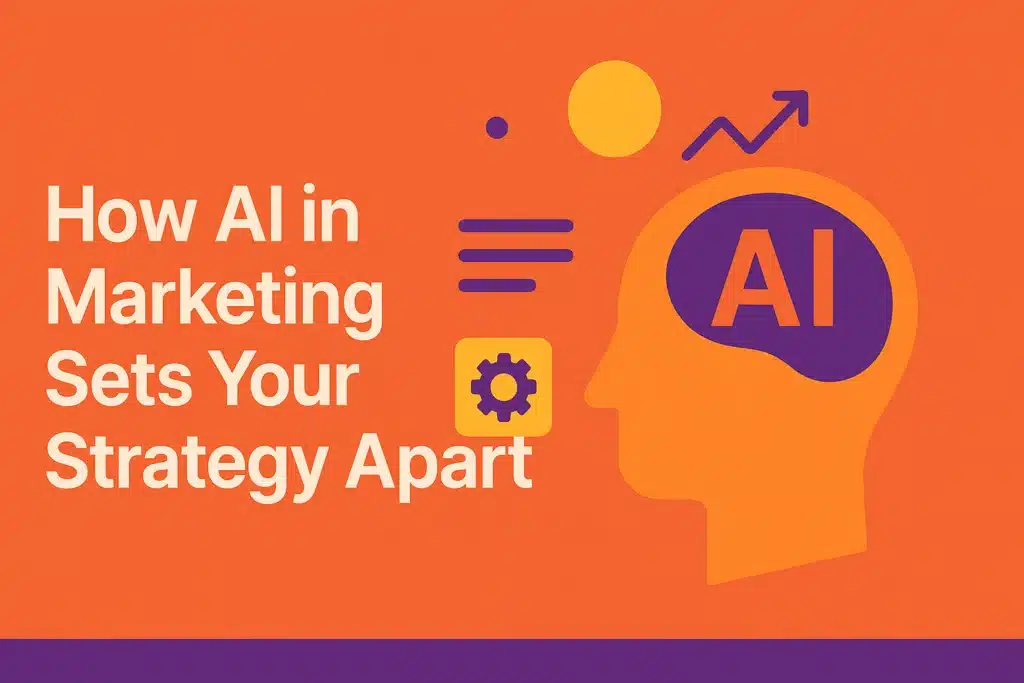AI in marketing grants businesses a strong edge by using data-led insights, automating time-consuming tasks, and reacting instantly to shifting market conditions. People in their mid-20s to late 40s want practical approaches, stronger efficiency, and clear reasoning about why AI truly matters. They value accurate, focused information that shows how AI raises marketing outcomes, reduces workload, and improves ROI. They also want plain language that outlines how solutions apply to real-world challenges, from budgeting constraints to segmentation puzzles. Below, discover how AI transforms marketing into a more refined and flexible practice at every turn.
With that context in mind, let’s explore each facet of how AI evolves modern marketing.
Boost marketing results with ai-powered insights
Automation and analytics combine to interpret user behaviors swiftly, helping marketers improve customer relations. Data-led forecasting highlights lucrative opportunities, ensures targeted outreach, and strengthens brand loyalty. AI also flags wasteful areas, saving ad spend. When human efforts merge with automated intelligence, campaigns gain deeper relevance and sharper focus.
How predictive analytics in marketing helps forecast trends
Predictive analytics uses data patterns to forecast shifts in consumer behavior. Marketers now analyze channels, track product usage, and even study voice-based queries to plan campaigns. AI-powered reports helped Function Growth achieve a 30% work rate boost in their marketing team (Improvado). By examining current and historic data, predictive analytics predicts buying habits. This practice helps allocate budgets more accurately and reduces wasted effort. It relies on algorithms, so it spots trends quickly. Businesses then align content, pricing, or outreach to meet emerging demands, improving campaign performance before rivals can react. It boosts swiftness.
Using ai for customer segmentation to personalize campaigns
AI customizes segments based on real-time data, such as browsing activity or recent purchases. By studying detailed behavior, it creates precise micro-segments that improve campaign relevance. In fact, a recent survey shows that 73% of customers expect a custom experience (CleverTap). AI also identifies valuable segments for future investment and boosts campaign performance review. Real-time segmentation ensures that marketers adjust outreach quickly. This approach encourages higher engagement, trust, and revenue. Through AI, businesses create highly targeted campaigns that match each customer’s habits and preferences. It automates changing updates to keep segments current.
How machine learning in marketing sharpens targeting strategies
Machine learning spots patterns in large datasets. This helps marketers design promotions for users who show a high likelihood of repeat purchases or churn risk. Chacka Marketing achieved a 90% reduction in manual reporting time (Improvado). Through psychographic details, ML tailors messages to personality traits or interests. It can also trigger event-based outreach when customers engage with new offers. Cross-sell and upsell predictions guide marketers toward better product combos. By automating segmentation and analysis, ML drives more strong targeting strategies, saving time and delivering consistent results. It refines campaigns constantly further.
Save time and cost with automation in marketing
Automation in marketing eases admin burdens by handling email scheduling, data entry, and other tasks. This reduces human error and overhead while boosting work rate. AI-driven workflows track performance, generate quick adjustments, and free marketers to focus on higher-level objectives. Businesses then allocate budgets wisely for growth. Costs fall greatly too.
Streamlining repetitive tasks with ai automation
Companies often spend hours on repetitive tasks, from data entry to basic customer support. AI systems can perform these tasks faster and with greater precision than humans (TTMS). Chatbots handle multiple queries at once, reducing staffing pressures. Finance teams benefit from automated invoice creation and payroll management, ensuring fewer mistakes. HR teams now automate routine screening of resumes. By eliminating mundane steps, employees work on strategic goals. Management then applies AI to forecast sales and analyze budgets without manual spreadsheets. This transforms operations and helps companies reclaim resources across departments immediately.
Boosting ROI from automated content creation and email flows
Automated content creation adjusts messages based on user interests, so each subscriber gets relevant offers. One retail brand that switched to advanced personalization reported a 42% increase in open rates and a 38% jump in conversions (LinkedIn). Predictive sending pinpoints when subscribers likely act, boosting conversions. Automated recovery sequences reclaim abandoned carts and lift revenue. By handling these workflows, teams save time and focus on strategy. Lifecycle emails reinforce brand relationships, raise retention, and lessen gaining costs. This combination translates directly into higher marketing returns. These automated flows reduce overhead considerably.
Combining ai tools to reduce manual workload and errors
AI tools integrate with existing systems, reduce labor-intensive tasks, and improve security through compliance features. According to MIT research, companies that implement AI-driven automation see a 40% work rate boost (Moveworks). They eliminate bottlenecks by handling complex processes. Generative AI cuts content creation time, letting teams revise and refine outputs faster. These platforms also handle real-time data analysis, identifying errors or anomalies before they escalate. By unifying disparate systems, AI reduces duplication and ensures consistent performance. This approach enables marketers to expand initiatives without burdening staff. IDC says spending hits $630 billion.
Make faster decisions backed by real-time data
Real-time data responds to consumer activities as they happen. Marketers then adjust pricing or content without delays. Live analytics eliminates guesswork by revealing shifts in engagement or demand. AI tools gather, process, and display evolving metrics in seconds. This helps swiftness, ensuring decisions reflect current conditions. Teams refine campaigns faster.
Using machine learning models to respond to user behavior
Machine learning models adjust to fresh data without waiting for batch updates. Real-time learning, sometimes called online ML, reviews new inputs quickly and outputs instant decisions. This approach suits e-commerce, where customer clicks or cart additions demand quick recommendations. Though ongoing online training remains experimental, it offers adaptability. Quix provides a streaming framework to handle data in Python without deep setup demands (Quix). By reacting to user activities, machine learning refines promotional tools or flags potential churn. This leads to more relevant marketing experiences and sharper results. Instant anomaly detection emerges.
Why real-time data insights improve performance and agility
Continuous data collection captures consumer behaviors as they happen. Over 80% of consumers expect custom experiences, raising purchase likelihood (Determ). Instead of relying on outdated metrics, brands change offerings when fresh trends surface. Managers detect wasteful areas faster and fix them before they escalate. This promotes flexible operations, because real-time feedback measures campaign impact instantly. Personalizing marketing messages in the moment boosts engagement by aligning with customer preferences. This approach also supports accurate competitor tracking, letting businesses tweak pricing or promotions to stay relevant and profitable. McKinsey research indicates revenue rises.
How ai in marketing improves ROI prediction accuracy
AI refines budget plans by spotting patterns behind lucrative channels. Harley-Davidson experienced a 2,930% return on ad spend by using AI for campaign improvement (RTS Labs). Tools like Google Ads’ Smart Bidding adjust bids in real-time, reducing waste. AI also personalizes promotions, fueling higher conversion rates. By analyzing historical and live data, these systems project revenue outcomes with more precision. This upgrades planning, because marketers gauge potential profits in advance. AI-driven predictions steer strategic decisions and decrease guesswork, leading to better ROI across various digital platforms. This uses advanced analytics.
Conclusion
AI changes modern marketing by speeding up results, saving costs, and refining strategies through real-time insights. Predictive analytics, customer segmentation, and machine learning keep campaigns relevant and effective. Automation frees teams from repetitive tasks, enabling them to create targeted outreach and content. Real-time data empowers marketers to shift immediately when market conditions shift, ensuring offers remain appealing. With advanced ROI forecasting, organizations allocate investments wisely. As AI tools grow more complex, they handle core processes that once demanded manual oversight. By using these systems responsibly, businesses build flexible marketing programs that connect with evolving customer preferences. Ongoing new innovation will shape stronger personalization, deeper insights, and sustained growth.
FAQ
Below are frequently asked questions on AI in marketing. These answers clarify how machine learning, predictive analytics, segmentation, and automation transform campaigns across industries. Explore deeper benefits and practical steps.
What are the advantages of using AI in marketing?
AI raises marketing work rate by automating tasks, refining audience segmentation, and boosting campaign precision. It also finds opportunities through rapid data analysis.
How is machine learning in marketing different from automation?
Machine learning identifies patterns and adapts, predicting future outcomes in dynamic environments. Automation follows preset rules, executing routine tasks without ongoing learning.
How does predictive analytics in marketing help with performance?
Predictive analytics sorts past and present data to forecast purchasing habits, allowing marketers to fine-tune campaigns more precisely and reduce wasted spending.
What tools support automation in marketing strategies today?
AI-based email platforms, chatbot builders, and analytics dashboards simplify processes by handling data entry, scheduling, segmenting, and automated follow-ups with precision.
Is using AI for customer segmentation more effective than traditional methods?
Traditional segmentation groups consumers into broad categories. AI refines segments using live data, building micro-groups that improve personalization reliability and impact.
What industries benefit most from AI in marketing right now?
E-commerce, finance, media, and retail see strong gains because AI-driven personalization, predictive modeling, and automated outreach enhance results and reduce overhead.

Ridam Khare is an SEO strategist with 7+ years of experience specializing in AI-driven content creation. He helps businesses scale high-quality blogs that rank, engage, and convert.



